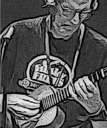A Curated Set of Learning Ukulele with Curt Lessons

Exploring Improvisation Using Tetrachords
Published: 01 Jan 2003
Updated: 08 Jun 2023 •
Visits: 66
Code: UL115
Traditionally, a tetrachord is a series of four tones filling in the interval of a perfect fourth. In modern usage a tetrachord is any four-note segment of a scale or tone row including the augmented fourth (+4). The term tetrachord derives from ancient Greek music theory, it literally means four strings.
When delving into improvisation, incorporating the concept of tetrachords as smaller modules of four notes, rather than adhering solely to a traditional scale approach, can make improvisation more approachable and manageable. By focusing on these compact segments, musicians can navigate and experiment within a narrower tonal range, allowing for greater exploration and creative expression in improvisational contexts.
Registered Members Only Access
5 Lessons in the “Exploring Improvisation Using Tetrachords” Series
Viewing the lessons in this Lesson Series is only available to Registered visitors with a Verified email address. This is all in an effort to cut down on the amount of spam registrations that we've been receiving.
The series lessons are also available individually in the Lessons area of the site. A Lesson series simply organizes these lessons into a logical sequence for learning.
🚀 🚧 End of LearningUkulele.com Site Content 🚧 🌍



.jpg)